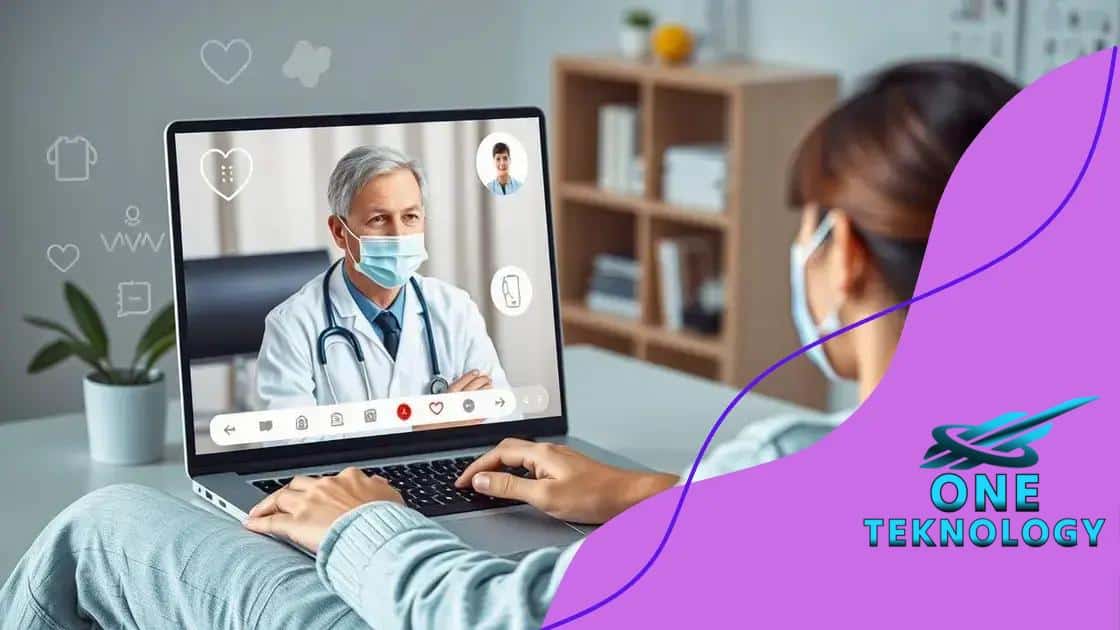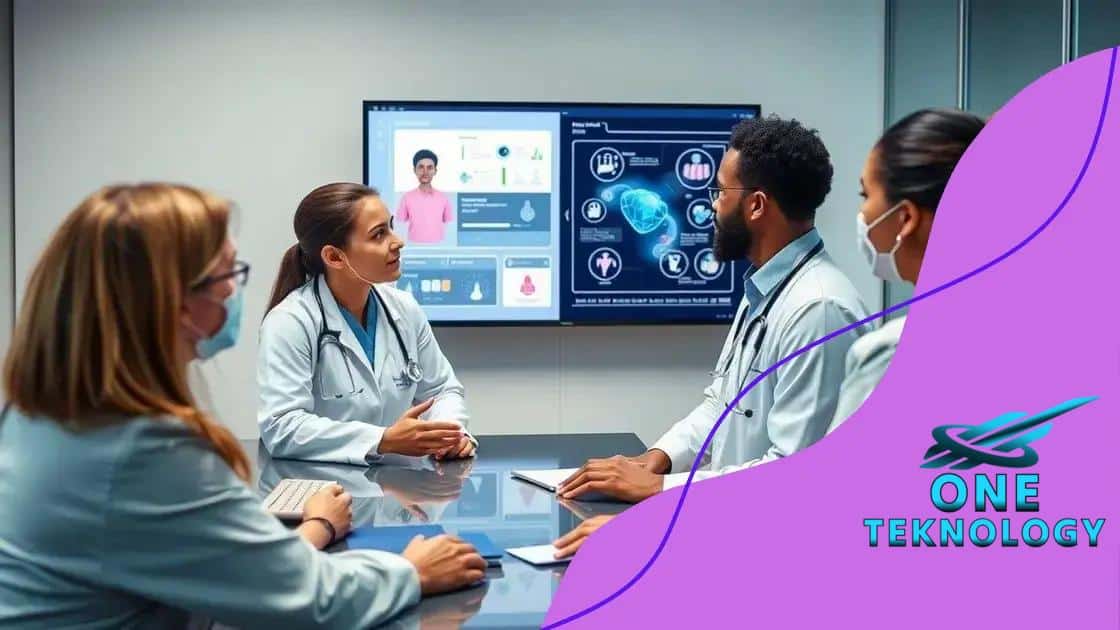How digital health services are changing access to healthcare

Digital health services are revolutionizing access to healthcare by integrating technologies like telehealth, AI, and wearables, which enhance patient engagement and streamline care delivery.
How digital health services are changing access to healthcare is a hot topic today. With technology advancing, it’s fascinating to see how these services are reshaping the patient experience and making healthcare more accessible than ever. Ready to dive in?
Understanding digital health services
Understanding digital health services is essential as we navigate the changing landscape of healthcare. These services leverage technology to enhance patient care, making healthcare more efficient and accessible.
What Are Digital Health Services?
Digital health services encompass a wide range of health-related activities that utilize technology. They can include everything from telemedicine to mobile health apps. By using digital tools, healthcare providers can better connect with patients and manage their health.
Key Types of Digital Health Services
- Telehealth platforms allow patients to consult with healthcare providers remotely.
- Health tracking apps help users monitor their fitness, nutrition, and other health metrics.
- Electronic health records (EHR) streamline patient data management.
- Online appointment scheduling makes it easier for patients to access medical services.
These services improve communication between providers and patients, fostering a more responsive healthcare system. For example, patients can receive timely advice without needing to visit a clinic in person.
The role of digital health services in preventive care is significant. By encouraging regular health monitoring, patients can catch potential issues before they develop into serious conditions. This proactive approach not only saves lives but also reduces overall healthcare costs.
Integrating technology into healthcare practices doesn’t just benefit patients; it also enhances workflow for providers. Advanced tools can minimize paperwork and streamline processes, allowing healthcare professionals to focus more on patient care.
Benefits of Digital Health Services
- Improved accessibility for remote or underserved populations.
- Increased patient engagement through interactive tools.
- Better management of chronic diseases through regular monitoring.
- Cost-effective options for both providers and patients.
As technology continues to evolve, understanding the various aspects of digital health services will be vital. The integration of these services will shape the future of healthcare, making it more efficient and accessible for everyone.
Benefits of improved access to healthcare
The benefits of improved access to healthcare resonate deeply with patients and providers alike. Enhanced access ensures that more people receive the care they need when they need it, ultimately leading to better health outcomes.
Key Advantages of Enhanced Access
First, it reduces the time patients spend waiting for appointments or in emergency rooms. Quick access to healthcare providers means timely interventions and less progression of diseases. Additionally, patients can utilize preventive services more effectively.
- Early diagnosis and treatment, reducing long-term health issues.
- Increased patient satisfaction from shorter wait times.
- Better management of chronic conditions through regular follow-ups.
- Lower healthcare costs due to fewer urgent care visits.
Moreover, when healthcare services are easily available, patients feel more empowered in their health decisions. They are more likely to seek care for minor issues before they escalate, fostering a culture of proactive health management.
Technology plays a significant role in enhancing access. With apps and telehealth services, individuals can connect with healthcare professionals from the comfort of their homes. This convenience encourages patients, especially those in rural areas, to seek assistance when necessary.
Social Impact of Improved Access
In addition to individual benefits, improved access to healthcare creates a positive ripple effect on communities. It can lead to healthier populations and lower rates of disease spread, benefiting everyone.
- Strengthened public health as communities access preventive care.
- Reduced health disparities among underserved populations.
- Improved workforce productivity as healthier individuals contribute more effectively.
- Enhanced community trust in healthcare systems.
In conclusion, the benefits of improved access to healthcare extend beyond just the individual. They foster healthier communities, cutting-edge technologies promote proactive health management, and individuals benefit from timely treatments and preventative care.
Challenges in implementing digital health solutions

Implementing digital health solutions brings both promise and challenges. While the benefits are numerous, various obstacles can hinder successful integration into healthcare systems.
Common Challenges Faced
One major hurdle is the issue of technology adoption by both healthcare providers and patients. Many practitioners are accustomed to traditional methods, making it hard to transition to digital platforms. To ease this shift, training and support must be provided.
- Lack of technical skills among healthcare staff.
- Patient resistance to using new technologies.
- Concerns over data security and privacy.
- Incompatibility between existing systems and new digital tools.
Another critical challenge is funding. Implementing digital health solutions requires investment in technology, infrastructure, and training. Without adequate financial resources, many healthcare providers struggle to adopt these necessary innovations.
Moreover, regulatory compliance can pose significant obstacles. Healthcare organizations must navigate complex regulations while integrating digital tools. Ensuring all solutions meet legal and ethical standards can be daunting.
The Importance of Addressing Challenges
Overcoming these obstacles is vital for the successful adoption of digital health solutions. Addressing issues such as technological hesitancy, funding gaps, and regulatory hurdles will pave the way for more effective patient care. This allows healthcare providers to enhance their services and applies modern practices that ultimately benefit patients.
When healthcare entities embrace change and seek to overcome these challenges, they can better harness the power of technology. This commitment to adaptation will not only improve individual patient experiences but also contribute to a more efficient healthcare system overall.
The role of telehealth in modern healthcare
The role of telehealth in modern healthcare is becoming increasingly important. In a world where convenience and accessibility matter, telehealth bridges the gap between patients and healthcare providers, transforming the way we approach medical care.
What Is Telehealth?
Telehealth refers to the delivery of healthcare services through digital technology. This includes video consultations, remote monitoring, and online communication. It makes it easier for patients to get the care they need without having to travel to a clinic.
- Patients can consult with doctors from anywhere.
- Reduced travel time and costs for patients.
- Flexible appointment scheduling increases convenience.
- Access to specialists regardless of geographical location.
Telehealth significantly expands access to care, especially for those in remote or underserved areas. Patients who might struggle to reach healthcare facilities can now receive essential consultations and follow-ups, promoting better health outcomes.
In addition to convenience, telehealth can enhance the quality of care. Providers can monitor patients’ conditions in real-time, adjust treatments quickly, and prevent complications before they escalate. This continuous connection leads to a more personalized healthcare experience.
Benefits of Telehealth
Integrating telehealth into regular practice offers numerous advantages. It encourages more patients to seek care, ultimately leading to early diagnosis and better management of chronic diseases.
- Increases overall patient engagement with their healthcare.
- Reduces the burden on emergency services.
- Lowers costs associated with in-person visits.
- Enhances patient satisfaction with more accessible services.
Telehealth also fosters a collaborative healthcare model. Health professionals can easily share patient information and collaborate on care strategies. This teamwork improves the patient journey, ensuring they receive comprehensive support.
In summary, the role of telehealth in modern healthcare is pivotal. As technology continues to evolve, telehealth will redefine the patient-provider relationship, making healthcare more accessible, efficient, and effective.
Future trends in digital health services
The future trends in digital health services are exciting and full of potential. As technology progresses, we can expect to see innovations that will further transform the healthcare landscape, making services more efficient and accessible.
Increased Use of AI and Machine Learning
One significant trend is the integration of artificial intelligence (AI) and machine learning in healthcare. These technologies can analyze vast amounts of data quickly, helping to predict patient outcomes and personalizing treatments.
- AI-driven diagnostics can lead to earlier detection of diseases.
- Predictive analytics can improve patient care management.
- Automated chatbots can provide immediate responses for patient inquiries.
- Machine learning models can refine treatment options based on real-time data.
As we embrace these technologies, healthcare providers will be able to offer tailored care that meets individual patient needs more effectively.
Telemedicine Expansion
Another trend is the continued growth of telemedicine. This branch of digital health services allows patients to access medical professionals from anywhere, reducing geographical barriers to care. As acceptance of telehealth grows, it is likely to become a standard part of healthcare delivery.
In particular, the convenience of virtual consultations appeals to patients who may have difficulty visiting a clinic. The use of telehealth can lead to greater patient satisfaction and improved health outcomes.
Wearable Technology and Remote Monitoring
The rise of wearable devices will also impact digital health services. These devices can continuously monitor health metrics, providing valuable data to both patients and healthcare providers. People can track their heart rate, blood pressure, and other important health indicators in real-time.
- Wearables promote proactive health management.
- Data collected can alert healthcare providers to potential issues early.
- Patients feel more engaged and responsible for their health.
- Remote monitoring can reduce the need for frequent in-person visits.
As these trends develop, the overall quality of healthcare is expected to improve. The intersection of technology and health will lead to more efficient systems, ultimately benefiting both patients and providers.
FAQ – Frequently Asked Questions about Digital Health Services
What are digital health services?
Digital health services use technology to deliver healthcare remotely, including telehealth consultations and health monitoring apps.
How can telehealth improve access to care?
Telehealth allows patients to consult healthcare providers from home, reducing travel time and increasing the convenience of receiving care.
What role does AI play in digital health?
AI helps analyze patient data for better diagnoses, predicts health outcomes, and can personalize treatment plans based on individual needs.
How do wearable devices contribute to healthcare?
Wearable devices track health metrics in real-time, providing valuable data to patients and healthcare providers for proactive management of health.






